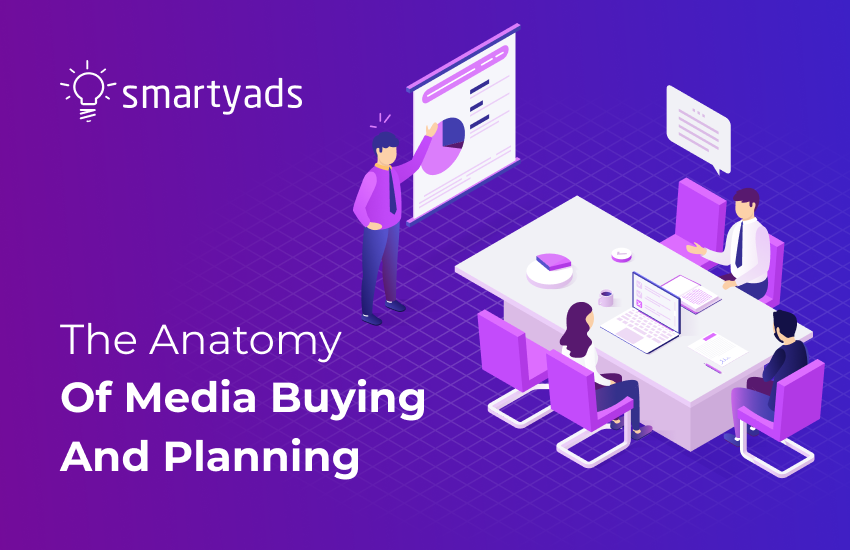Proven by time and experience advertising realizes a wide range of tasks for any company: quickly attracting the attention of the target audience, reminding loyal customers about the product, and increasing the number of potential customers; it is not a complete list of all the good things you can do with the help of the media planning.
In order to place an advertisement on the Internet, in print media, or on broadcast media, you have to find that ad space and buy it.
It takes a lot of time, so special platforms that minimize human involvement in the process of media buying and planning have taken over the Internet.
They are called programmatic platforms, and the ads placement performed this way is called programmatic advertising. The platform not only provides algorithmic purchase of advertising and automation of operations but also an intelligent system, which is self-learning from the history of transactions.
The purchase of media space for the purpose of subsequent resale to the advertiser became known as Media Buying or Media Planning.
Digital media buying and planning
One of the fastest-growing types of media buying today is considered digital media buying. Internet advertising takes a more important and fundamentally new role in the modern business and life of ordinary people.
The main advantage of digital advertising is its direct interaction with target audiences in the context of websites, social networks, and mobile applications.
A certain time is given for using the ad space (or rather its rent), stipulated in the contract. The cost of banner advertising space, for example on social networks, depends largely on the attendance of the resource by the target audience.
The price also depends on the number of clicks from other platforms and views, clicks on ads, and purchasing actions taken by potential customers. And the price of broadcast time on the radio and TV — channels have other rates: it is calculated by the minute. On the TV channel, the cost also depends on the ratings.
The price of buying publications on outdoor advertising media (street, transportation) depends primarily on location, the size of the construction, and the material of which it is made. Accordingly, the cost of promotion of the company in print media is higher in the main regions of the country and the popularity of the media.
How does digital media buying process work?
Media planning and buying involves strategy, negotiation, and ad placement. Skilled media buyers understand that profitable media buying is a science close to art.
Media buying and planning is a fairly lengthy process that can be broken down into 5 basic steps, which we'll discuss further in this article.
The 5 Steps of media buying and planning
Digital media buying and planning is a process that helps companies and brands connect with potential customers and media buyers as they go through the four steps of the buying journey.
The five steps of the media planning and media buying process are:
- Determine your target audience after comprehensive market research of your business niche;
- Understand the interests of your audience;
- Find your audience and understand when they are most receptive to your messages;
- Provide captivating creative that motivates them to take action;
- Test and retest ad placements and creatives to find out what works and what doesn't. Refine and improve your ad campaigns.
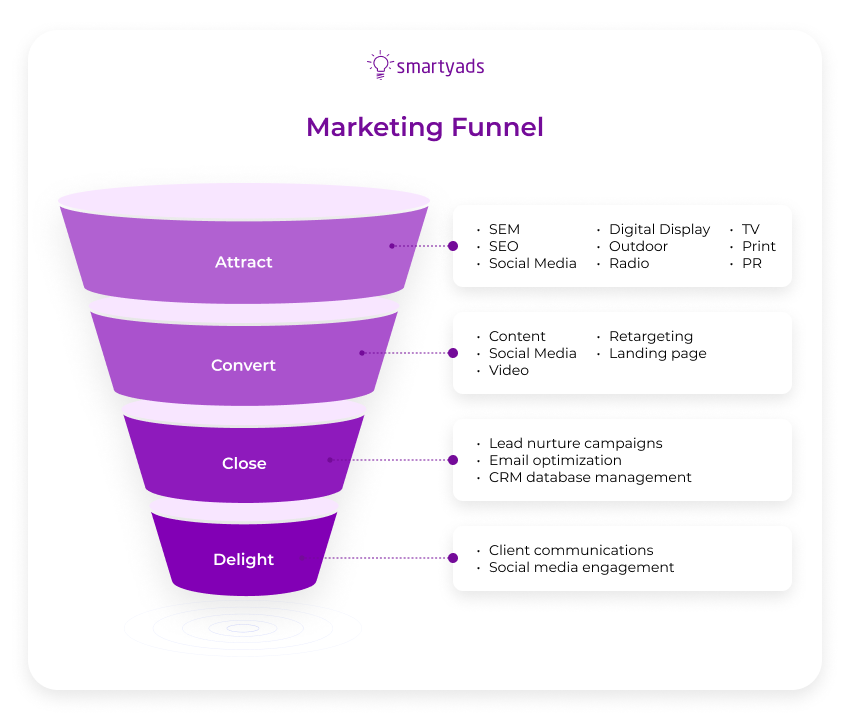
The first step of the media planning process involves using research tactics that you can utilize to know and understand your ideal target audience.
However, you need to not just engage your audience with content related to your product, but also get them interested in purchasing your product or service.
Marketing research to study the target audience
Internal market research
To begin with, a good media buyer needs to learn the business and the nuances involved in running it. This is especially important if the media buyer is an outside hire who was invited specifically for the purpose of media buying or media planning for a particular company.
Such research helps media buyers to better understand the target audience and the company's needs and to prepare the ground for conducting external research.
External market research
Such research is necessary for all media buyers in order to study the situation in the target market. For full-scale external research, the media buyers study the target audience, the media resources, which can be used to reach it, and the time, when the target audience is most likely to be active. Based on all of this data, media buyers can get a fairly reliable picture of when, where, and how best to get views and conversions from a particular advertising offer.
Media buyers can also establish media goals based on this data.
Establishing Media Goals
After performing market research and studying the target audience, media planners must figure out which media channels will be most effective for the business. These can range from traditional media such as newspapers and magazines, outdoor advertising, radio or television, or innovative media channels such as programmatic advertising, CTV, DOOH, or native advertising.
Of course, modern forms of media competitively win over traditional media, because with less investment and due to more accurate targeting, they show better results.
In addition, any change in a programmatic ad campaign can be quantified and its effect on the final result can be counted by media buyers. With traditional media, analytics is much less accurate.
However, there is a certain percentage of the audience that is still easier to reach through traditional media. Besides, for large corporations, traditional media is more of a tool to increase brand awareness and an auxiliary source of potential customers.
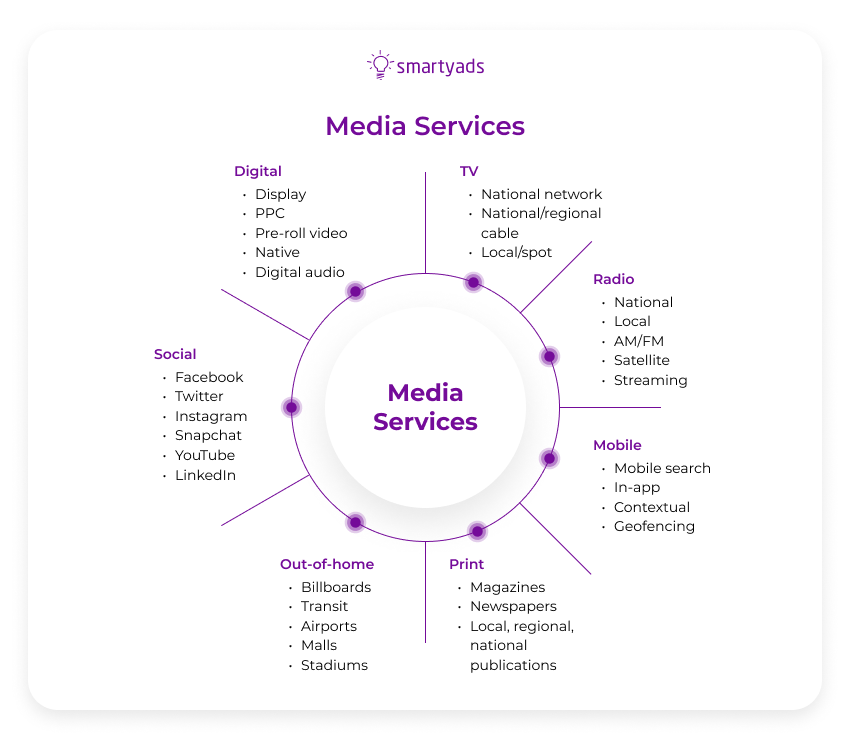
After analyzing the various media channels and setting goals, a good media buyer is likely to be interested in what inventory a particular advertising platform has to offer.
It's hard to say what kind of inventory would be good for any particular business, but that's the question a good media buyer should know the answer to. At the very least, if you don't have a media buyer at your disposal, you can always ask for help from the technical support of a potential programmatic platform, usually, such platforms provide consulting services.
Types of media buying
Programmatic advertising on digital displays
It's the type of digital media buying. The main advantage of programmatic digital display advertising is its ability to target a specific audience, depending on its position in the sales funnel.
Today, the criteria for targeting are limitless. It often makes sense to create a targeting audience using your own data, such as a list of current customers of the product or service you want to promote. Use smart data visualization and analytics tools to identify similarities and similar audiences that match the profiles of those customers.
Once you've compiled this list, you'll have your ideal target audience. You can target them with messages from your company or by using specific ad space for ad placements.
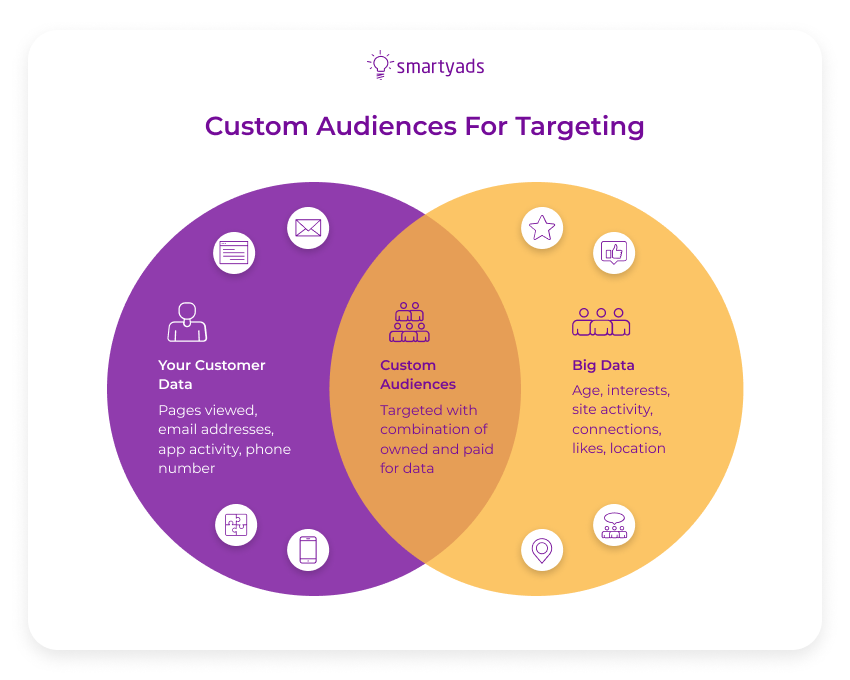
Once you've identified your ideal audience, you can add additional target audiences based on their position in your sales funnel.
Additional criteria for supplementing your audience:
- Demographic variables;
- Geographic/geo-zone variables;
- Behavioral variables;
- Keywords (SEO targeting);
- Categories of interest;
- Targeting by IP address;
- Audience of interested media buyers;
- Similar audiences and custom audiences;
- Retargeting and remarketing.
Marketing funnel targeting looks like this:
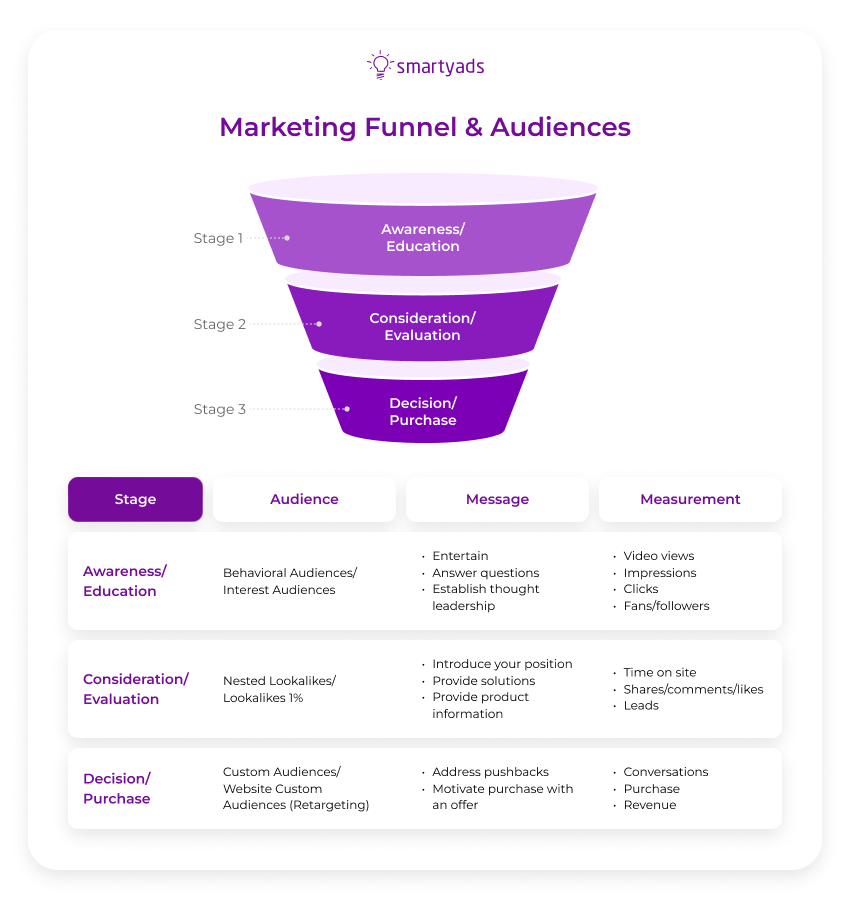
All of the messages and creatives that a potential customer sees should resonate with each other and complement each other in order to move them further down the sales funnel.
Different media payment models
Today, there are several models of online media buying, which can be used simultaneously on different platforms, depending on your budget:
CPC (Cost Per Click)
Price per click. The most popular media buying model. In this case, the advertiser pays only when the user who viewed the ad, makes the desired target action (for example, moves to the site).
CPL (Cost Per Lead)
The price per lead. The advertiser pays for advertising only when the user filled in and sent a form to potential clients. This form is rarely used because it is not profitable for the publishers, and is usually found in the B2B marketing sector where the user needs to first contact the company before making a purchase.
CPA (Cost Per Action)
Price per action. The advertiser pays when a user performs a certain action on their site. For example, buys, registers, subscribes, etc.
CPM (Cost Per Mille)
The price per thousand impressions. The advertiser pays for their ad just to be shown, regardless of the effectiveness of that display, but the payment is made for every thousand impressions.
CPI (Cost Per Install)
The price per install. This model is relevant only for mobile and computer applications when the advertiser pays for each download of their software to the user's computer or phone.
It's all also types of digital media buying. As you know, most customers today do a little research on the Internet before they buy anything. Therefore, pay-per-click advertising can be a profitable investment to increase conversions.
At the same time, pay-per-thousand-view ads are good for increasing audience awareness of your brand. By placing ads in front of users who are searching for keywords based on intent, you increase your chances of increasing awareness and attracting leads.
You can use the following criteria to target your audience for such ads:
- Age;
- Gender;
- Parental or marital status;
- Family income;
- Social status;
- Level of education.
Once the ad campaign is set up and configured, don't forget to correct it and analyze the results. A successful ad campaign will always be just one step ahead, but that doesn't mean you should stop striving for it.
Media buying on social networks
Whereas social networks used to be just a tool for social interaction, today, beyond their original function, they have become a platform for advertising or sales as well as the media planning phase. Many users skip the search page and prefer to make purchases directly through social networks. Purchase decisions are no longer made on a particular product or service page, but on the expanses of Twitter, Facebook, Instagram, and YouTube.
Social networks are paid media because it is possible to achieve organic growth of subscribers, but in a highly competitive environment it is extremely difficult and unprofitable in terms of the time it may take. It is much easier to use the services of paid advertising in a social network and get the necessary flow of traffic from some advertising proposal.
It's important to be aware of which social network your audience may be on. You can call it marketing ageism, but it's obviously easier to find older audiences on Facebook now, while it's easier to find zoomers and millennials on Instagram or Tiktok.
With solid digital marketing tactics and proper media planning, you can achieve your goals by using paid advertising tools on social media.
Media buying on radio and television
While the first thing we think of when talking about digital marketing is media buying on search engines or social media, we shouldn't forget traditional channels for media buying either.
Radio and television, like any other media, are moving with the times and developing their own methods to update their advertising platforms. Now traditional linear TV is losing ground to CTV and OTT, but both linear TV and streaming services are great channels to reach your potential customers.
Depending on your ad campaign goals, budget, and ad creative options, you may find it appropriate to use some of these media. For analytics, independent ratings like Nielsen, ComScore ratings, TVB, and Scarborough information are very advantageous. They can help you choose where to place ads and predict their effectiveness.
Many media buyers forget about radio or don't consider it a worthwhile channel, but today radio is also a great way to target your ads. For example, streaming services like Pandora, Spotify, and iHeartRadio allow listeners to create their own playlists. This means that people are more likely to listen to recordings for longer, creating opportunities to revisit your messages.
In addition, if your brand is targeting an audience in a particular location, it may be a good solution to reach out to a local radio station.
Media buying and SEO
Search engine optimization is a scary word that everyone is familiar with, but only a few know it closely. SEO can be part of a media buying strategy, so it should not be forgotten about when we talk about media buying or media planning process.
Search engine optimization is a specific list of actions aimed at ensuring that your site has a higher position in the search results from Google, Bing, or Yahoo. These actions can be directed to optimize the content of your site and on the technical side. That's why it's crucial, if not to have your own SEO specialist, then at least to regularly request audits from third-party companies that specialize in such things.
Search engine optimization is extremely broad and involves many different activities.
What does full SEO support include:
- SEO audit and strategy;
- On-Page SEO;
- Technical SEO;
- External SEO.
Media buying billing and cross-checking
After buying ad space and placing ads, it's time to do some analytical work. You need to adjust your settings and figure out the most winning ad placement strategy. In addition, it is worth evaluating all of your media accounts and reconciling them with ad placement orders to make sure that you received everything you were promised during the media purchase negotiations.
If you find discrepancies, they will be easier to correct.
Programmatic in media buying and media planning
If you don't want to apply to an agency for media planning, and you don't want to contact publishers and negotiate with them yourself either, you can automate the media buying process.
You can use special demand-side platforms (or supply-side platforms if you're a publisher), where the traffic is purchased through direct interaction with advertising networks, exchanges, and sites, which actually saves you from having to jump from platform to platform manually. Also, using a demand-side platform often allows you to minimize your ad costs and set up your own filters for display ads so that only your target audience sees them exactly.
All of the benefits of media buying are:
A really large selection of different media platforms, making media buying suitable for almost any business, sector, and product;
In automated media buying, human involvement is minimized, and all transactions and ad impressions are the responsibility of special algorithms. At the same time, media buying also becomes fast and cheap, and the effectiveness of advertising remains at the same level;
Availability of real-time analytics through both automated platforms and the publisher's own reports;
The ability to personalize advertising parameters and detail targeting based on audience demographics.
There are only two disadvantages of programmatic media planning, but they are indirect. Firstly, it is necessary to carefully study the product and its audience before you buy advertising, because in case of an error, the advertisement will not be canceled, and it will not have the desired effect.
Secondly, there may be cases of fraud in digital media planning, for example, scamming the impressions and clicks by bots, so that the advertiser paid more. But as a rule, only little-known platforms do this, because the well-known ones value their reputation (but their prices are also solid).
Bottom Line
Media planning is a very important part of how any business operates, so it should be approached thoroughly. These days, the competition in the market does not allow even the most promising start-ups to relax, forcing them to dive into the world of buying advertising. A competent media planning strategy can increase your brand's profitability many times over, while not taking this task seriously enough can destroy your brand and its reputation in a few days or even hours.
Programmatic platforms are designed to simplify the ad-buying process. They help make it more transparent and understandable, even for people who are new to the need for media planning. DSP and SSP platforms offer an accessible and intuitive interface that makes it easy to manage all your ad campaigns or ad platforms from one place. So if you don't have the resources or need to hire a whole staff of media buyers, a programmatic platform would be a great solution for your brand.
